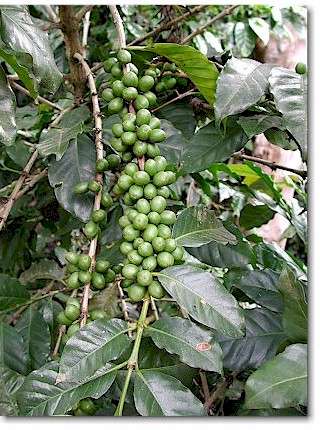|
The Arabica and Robusta Coffee Plant
Coffee Plant Overview
The coffee plant is a woody
perennial evergreen dicotyledon that belongs to the Rubiaceae family. Because it grows to a relatively large height, it is more accurately described as a coffee tree. It has a main vertical trunk (orthotropic)
and primary, secondary, and tertiary horizontal branches (plagiotropic).
The Difference Between Arabica and Robusta Coffee Beans
While there are several different coffee species, two main species are cultivated today.
Coffea
arabica, known as Arabica coffee, accounts for 75-80 percent of
the world's production. Coffea canephora, known
as Robusta coffee, accounts for about 20 percent and differs from the Arabica coffees in terms of taste. While Robusta coffee beans are more robust than the Arabica plants,
but produces an inferior tasting beverage with a higher caffeine
content. Both the Robusta and Arabica coffee plant can grow to heights of 10
meters if not pruned, but producing countries will maintain
the coffee plant at a height reasonable for easy harvesting.
 Coffee Plant Growth and Development Coffee Plant Growth and Development
Three to four years after the coffee is planted,
sweetly smelling flowers grow in clusters in the axils of
the coffee leaves. Fruit is produced only in the new tissue.
The Coffea Arabica coffee plant is self-pollinating, whereas the Robusta
coffee plant depends on cross pollination. About 6-8 weeks
after each coffee flower is fertilized, cell division occurs and
the coffee fruit remains as a pin head for a period that is dependent
upon the climate. The ovaries will then develop into
drupes in a rapid growth period that takes about 15 weeks
after flowering. During this time the integument takes
on the shape of the final coffee bean. After the rapid growth
period the integument and parchment are fully grown and will
not increase in size. The endosperm remains small until
about 12 weeks after flowering. At this time it will
suppress, consume, and replace the integument. The remnants
of the integument are what make up the silverskin. The
endosperm will have completely filled the cavity made by the
integument nineteen weeks after flowing. The endosperm
is now white and moist, but will gain dry matter during the
next several months. During this time the endosperm
attracts more than seventy percent of the total photsynthesates
produced by the tree. The mesocarps will expand to form
the sweet pulp that surrounds the coffee bean. The coffee cherry will
change color from green to red about thirty to thirty-five
weeks after flowing. See Flash movie on Coffee
Bean Development.
Coffee Plant Root System
The roots
of the coffee tree can extend 20-25 km in total length (Malavolta,
195) and the absorbing surface of a tree ranges from 400
to 500 m2 (Nutman).
There are main vertical roots, tap roots, and lateral roots
which grow parallel to the ground. The tap roots extend
no further than 30-45 cm below the soil surface. Four
to eight axial roots may be encountered which often originate
horizontally but point downward. The lateral roots can
extend 2 m from the trunk. About 80-90% of the feeder
root is in the first 20 cm of soil and is 60-90 cm away from
the trunk of the coffee tree (Mavolta, 195-196). However, Nutman states that the greatest root concentration is in the 30 to
60 cm depth. The roots systems are heavily affected
by the type of soil and the mineral content of the soil.
To be thick and strong, the coffee roots need an extensive
supply of nitrogen, calcium and magnesium. During planting
the main vertical roots are often clipped to promote growth
of the the horizontal roots, which then have better access
to water and added nutrients in the top soil.
Coffee Leaves
The elliptical
leaves of the coffee tree are shiny, dark green, and waxy.
The coffee bean leaf area index is between 7 and 8 for a high-yielding
coffee (Malavolta, 195).
The coffee plant has become a major source of oxygen in much
of the world. Each hectare of coffee produces 86 lbs
of oxygen per day, which is about half the production of the
same area in a rain forest (source: Anacafe).
Related
Articles:
Coffee
Bean Development
Growing
Coffee
Planting
Coffee
Environmental
Conditions for Growing Coffee
Climate
|


